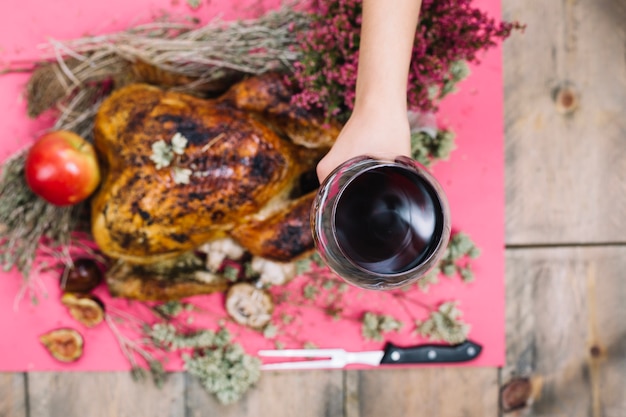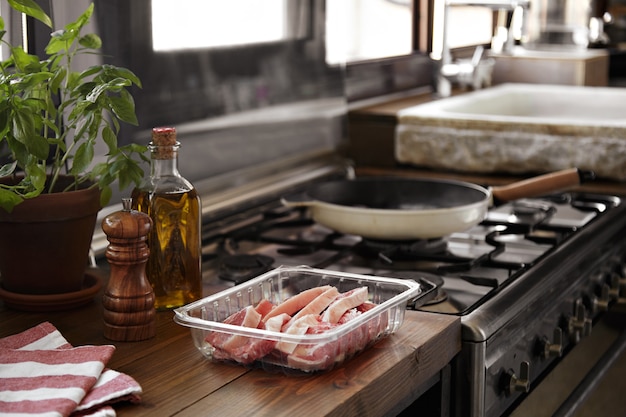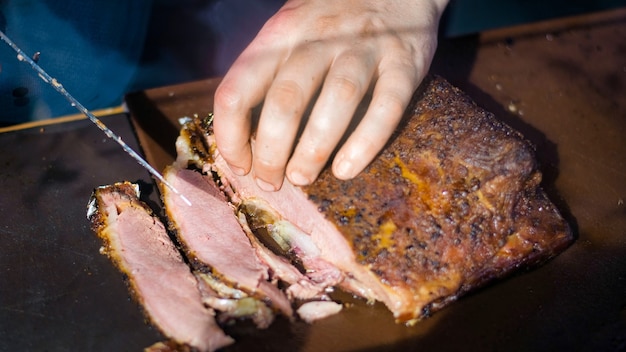Let's face it, there are few things in life as satisfying as a perfectly cooked prime rib roast. The rich aroma, the beautifully browned exterior, the melt-in-your-mouth tenderness – it’s pure culinary magic. But let’s be honest, it can also be a little intimidating to tackle. There's the fear of overcooking, the worry about achieving that perfect crust, and the pressure of making sure everyone gets a delicious slice.
But worry not, my fellow food enthusiasts! I've been there, done that, and learned a thing or two about conquering the prime rib roast. This is my ultimate guide, packed with tips, tricks, and insider knowledge gleaned from years of experimenting and, yes, even some epic roast-related disasters. I’m going to walk you through every step, from choosing the perfect cut to the final resting stage. Get ready to elevate your cooking game and become a prime rib master!
(Part 1) choosing the right cut: The Foundation of a Stellar Roast

The Prime Rib: Understanding the Star of the Show
You’ll find the prime rib cut in the rib section of the beef, usually containing 7 to 9 ribs. This cut is called “prime” for a reason: it’s the most marbled part of the beef, meaning it’s packed with those beautiful streaks of fat that translate to juicy, flavorful meat.
Bone-In or Boneless? A Choice of Convenience and Aesthetics
Now, the big question: bone-in or boneless? Bone-in roasts are a classic choice. The bone helps to conduct heat, ensuring even cooking. Plus, they look impressive on the table, a beautiful centerpiece for a special occasion. Boneless roasts, on the other hand, are a bit easier to carve and are often preferred for their greater convenience.
Size Matters: Finding the Perfect Fit
And of course, the size matters! You want to choose a roast that’s big enough for your guests but not so large that you’re dealing with prime rib leftovers for a week. A general rule of thumb is to allow 1 pound of prime rib per person. For a small gathering, a 3-4 pound roast is perfect. For larger groups, you might need to go up to 6-8 pounds or even more!
(Part 2) Getting Ready: The Preparation Makes All the Difference

Unpacking the Roast: A Culinary Masterpiece
When you bring that glorious prime rib home, take a moment to appreciate it. This is a piece of culinary art! Now, give it a good rinse under cold water and pat it dry with paper towels.
Trim Away Excess Fat: It’s Not Always About “More is Better”
You can trim away any excess fat, but remember, fat equals flavor! I recommend leaving a thin layer of fat to help keep the roast juicy and develop a beautiful, crispy crust.
Seasoning the Star: Unleash Your Culinary Creativity
Here’s where the fun begins! I like to start with a generous sprinkle of kosher salt and freshly ground black pepper. Then, it’s time to get creative! A blend of garlic powder, onion powder, dried rosemary, thyme, and paprika is a classic combination. But don't be afraid to experiment with your favorite herbs and spices. I’ve found that a pinch of smoked paprika adds a depth of flavor that elevates the roast to new heights.
Tie It Up: Keeping It Together for Even Cooking
If you're using a bone-in roast, tie it up with kitchen twine to create a uniform shape. This will help ensure even cooking and prevent the roast from drying out. If you're using a boneless roast, tying it up might be a good idea too, especially if it’s a larger cut.
(Part 3) Roasting the Prime Rib: The Heart of the Process

Oven Prep: Setting the Stage for Success
Preheat your oven to 450°F (232°C). While the oven is getting hot, grab a roasting pan big enough to comfortably hold your prime rib.
Getting Started: Placing the Star in the Spotlight
Place the prime rib in the roasting pan, fat side up. This allows the fat to render and baste the roast as it cooks, creating a self-lubricating system that ensures juicy, flavorful results.
Initial Roast: The First Blast of Heat
Now, slide that beauty into the preheated oven. You want to give it a good initial sear, about 15 minutes, to get that beautiful, crispy crust. This searing process creates a barrier that helps retain moisture and locks in those delicious flavors.
Temperature Check: A Critical Step in Perfecting Doneness
After 15 minutes, reduce the oven temperature to 325°F (163°C). Now, it's time to watch the temperature closely. The goal is to cook the roast to an internal temperature of 135°F (57°C) for medium-rare. You can use a meat thermometer to check the temperature in the thickest part of the roast.
Resting Time: Letting the Magic Work
When the roast reaches your desired temperature, take it out of the oven and let it rest for at least 15 minutes, covered loosely with foil. This is crucial to allow the juices to redistribute and create a tender, juicy roast.
(Part 4) The Magic of the reverse sear: A Different Approach to Prime Rib Perfection
Embrace a Different Approach: Breaking the Rules
I used to be a bit of a traditionalist when it came to roasting prime rib. But then I discovered the reverse sear method, and my culinary world was flipped upside down! This method, which involves cooking the roast at a lower temperature for a longer period, yields a more tender and juicy roast, with an equally impressive crust.
Gentle Cooking: Slow and Steady Wins the Race
Preheat your oven to 250°F (121°C) and roast the prime rib for about 2-3 hours, or until the internal temperature reaches 125°F (52°C) for medium-rare. This gentle cooking ensures that the meat cooks evenly and retains its natural moisture.
The Big Finish: The Final Blast of Heat
Once the roast has reached the desired temperature, crank up the oven to 450°F (232°C) and sear for 10-15 minutes. This will give you that crispy, golden-brown crust that everyone loves.
(Part 5) Basting: A Little Love Goes a Long Way
The Art of Basting: Keeping Things Moist and Flavorful
While the prime rib is roasting, don’t forget about basting! This simple step makes a big difference in achieving a juicy, flavorful roast. You can use pan drippings, beef broth, or even a simple mixture of butter and herbs for basting.
Basting Frequency: A Matter of Consistency
Baste the roast every 30-45 minutes during the cooking process. This helps to keep the meat moist and add flavor.
Don’t Forget the Pan: The Source of Deliciousness
As the fat renders and drips into the roasting pan, you'll be left with some delicious pan drippings. Don’t discard those! You can use them to make a delicious gravy or sauce to serve with the prime rib.
(Part 6) Resting: The Final Touch
Patience is a Virtue: Letting the Roast Relax
Once the roast is cooked to your desired temperature, resist the urge to carve it immediately. Give it at least 15 minutes to rest, covered loosely with foil.
Why Resting Matters: Redistributing the Juices
This resting period allows the juices to redistribute throughout the meat, resulting in a more tender and juicy roast. It also helps the roast to firm up slightly, making it easier to carve.
The Magic of Resting: The Final Step Before Carving
After the resting period, your prime rib will be ready for carving. You'll notice that the meat is beautifully pink, tender, and full of flavour.
(Part 7) Carving: A Culinary Dance
Tools of the Trade: The Essentials for a Clean Cut
You'll need a good, sharp carving knife for this task. A carving fork will also be helpful to hold the roast steady as you carve.
Slice It Up: A Symphony of Slices
Start by carving the roast into individual slices, about ?? inch thick. Be sure to carve against the grain of the meat, which will make the slices tender and easier to chew.
Presentation is Key: Turning a Roast into a Work of Art
Once you've carved the roast, arrange the slices beautifully on a platter. You can garnish the platter with fresh herbs, roasted vegetables, or even a simple drizzle of pan drippings. This is your masterpiece, folks!
(Part 8) Serving: A Celebration of Flavor
The Feast Begins: Bringing it All Together
Serve your prime rib with your favourite sides. Roasted potatoes, asparagus, green beans, and Yorkshire pudding are classic pairings.
Embrace the Sauce: A Final Touch of Richness
Don't forget the gravy or sauce! It will add a rich and flavorful element to the dish. You can use the pan drippings to make a simple gravy, or get more creative with a red wine reduction sauce or a creamy horseradish sauce.
Enjoy the Moment: Sharing the Fruits of Your Labor
Gather your loved ones around the table, pour a glass of your favourite beverage, and enjoy the fruits of your culinary labour!
(Part 9) Prime Rib Leftovers: Deliciously Versatile
The Leftovers Advantage: More Meals to Come
Don't let those leftover prime rib slices go to waste! There are countless ways to use them up.
Sandwiches, Anyone? A Prime Rib Classic
Make delicious prime rib sandwiches with crusty bread, cheese, and your favourite toppings.
Prime Rib Hash: A Hearty and Flavorful Option
Dice up the leftover prime rib and combine it with potatoes, onions, and your favorite seasonings for a hearty hash.
Soup Delight: A Comforting Leftover Option
Prime rib makes a fantastic base for a hearty soup. Simply add the meat to your favourite soup recipe for a flavour-packed meal.
Prime Rib Salad: A Light and Delicious Choice
Add some sliced prime rib to your favourite salad for a protein-rich and delicious meal.
(Part 10) FAQs: Your Prime Rib Queries Answered
What Temperature Should I Cook Prime Rib?
For medium-rare: 135°F (57°C)
For medium: 140°F (60°C)
For medium-well: 145°F (63°C)
How Long Does It Take to Cook a Prime Rib?
The cooking time for prime rib depends on the size of the roast and the desired doneness. A general rule of thumb is to allow 15 minutes per pound of roast at 325°F (163°C).
Can I Cook Prime Rib in a slow cooker?
While you can technically cook prime rib in a slow cooker, it’s not recommended. The slow cooker will not produce the same crispy crust and juicy interior as an oven-roasted prime rib.
Can I Freeze Prime Rib?
Yes, you can freeze prime rib. Wrap it tightly in plastic wrap and aluminum foil, and freeze for up to 3 months.
What are Some Good Prime Rib side dishes?
Some classic side dishes for prime rib include roasted potatoes, asparagus, green beans, Yorkshire pudding, and creamed spinach.
A culinary adventure Awaits!
So, there you have it, my ultimate guide to cooking the perfect prime rib roast. It’s a journey that starts with selecting the right cut and ends with a table full of happy guests. Remember, it's all about finding the right approach and embracing the process. Don't be afraid to experiment, try new things, and have fun in the kitchen! And who knows, you might even become the prime rib master of your household!
Everyone is watching

How to Cook Frozen Lobster Tails Perfectly: A Step-by-Step Guide
RecipesLobster. Just the word conjures up images of lavish meals, special occasions, and a taste of luxury. But let's...

Pigs in a Blanket Cooking Time: How Long to Bake for Perfect Results
RecipesAh, pigs in a blanket. Just the name conjures up images of those delightful little parcels of crispy pastry en...

Pork Fillet Cooking Time: How Long to Cook It Perfectly
RecipesPork fillet, or tenderloin as it's sometimes called, is a real favourite in our house. It's so versatile, and...

The Ultimate Guide to Cooking Delicious Frankfurters
RecipesLet's face it, we all love a good frankfurter. It's a classic, simple, and always satisfying. But let's be rea...

Wolf Meat Recipes: A Guide to Cooking Wild Game
RecipesLet's be honest, you don't see wolf meat at your local butcher shop every day. It's a bit of a wild card, but ...
